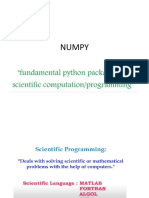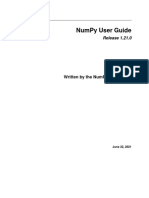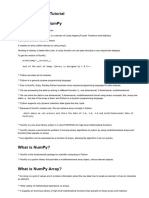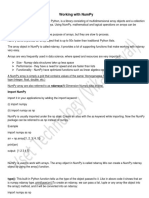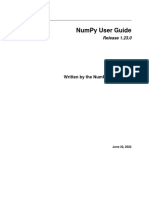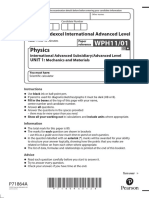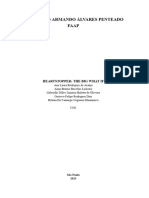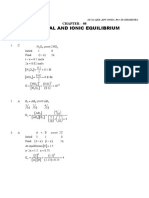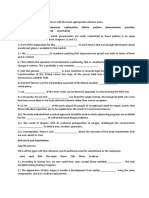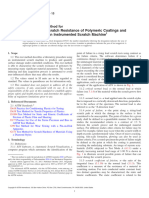Numpy Tutorial Summary (Video 1-5)
Here are your detailed, concise, and clearly explained study notes based on the first 5 videos of
CampusX’s NumPy tutorial series:
✅ Video 1: Introduction to NumPy
📌 What is NumPy & Why Use It?
NumPy is a Python library used for numerical and scientific computing.
Solves limitations of Python lists:
Slow for large data
Require explicit loops for element-wise operations
Inefficient memory usage
🧠 Key Concepts
NumPy arrays (ndarray) are:
Homogeneous (same datatype)
Faster than lists (thanks to C-level optimization)
Memory efficient
Vectorized: Element-wise operations without loops
Broadcasting: Automatic shape alignment for operations
🔧 Functions / Methods
python
import numpy as np
arr = np.array([1, 2, 3])
type(arr) # <class 'numpy.ndarray'>
python
arr + 2 # Adds 2 to each element
arr * 3 # Multiplies each element by 3
💡 Tips
Always use NumPy for numerical computations instead of lists.
Use vectorized operations over loops for better performance.
Printed using ChatGPT to PDF, powered by PDFCrowd HTML to PDF API. 1/4
�✅ Video 2: Practical Use Cases of NumPy
📌 Where is NumPy Used?
Data Science & Machine Learning: Linear Algebra, preprocessing
Image Processing: Each image is an array (pixels)
Signal Processing: Time-series manipulation
Physics/Engineering Simulations: Matrices, numerical methods
⚙️ Practical Scenarios
Processing large datasets with NumPy arrays
Using slicing and broadcasting to clean and scale data
Matrix multiplication for ML models (via @ operator or np.dot)
💡 Takeaway
NumPy is not just faster, but also integrates well with other libraries like Pandas, OpenCV, Scikit-
learn, etc.
✅ Video 3: Creating N-Dimensional Arrays
📌 Understanding Dimensions
1D: List-like → [1, 2, 3]
2D: Matrix-like → [[1, 2], [3, 4]]
3D: Tensor-like → [[[1, 2], [3, 4]], [[5, 6], [7, 8]]]
🔧 Key Properties
python
a = np.array([1, 2, 3]) # 1D
b = np.array([[1, 2], [3, 4]]) # 2D
c = np.array([[[1,2],[3,4]], [[5,6],[7,8]]]) # 3D
print(a.ndim) # Number of dimensions
print(b.shape) # Rows x Columns
print(c.size) # Total number of elements
print(c.dtype) # Data type of each element
💡 Tips
Always check dimensions using .ndim and .shape before applying operations.
Shape mismatch is a common error—use .reshape() if needed.
Printed using ChatGPT to PDF, powered by PDFCrowd HTML to PDF API. 2/4
�✅ Video 4: Important Attributes in NumPy
📌 Attributes = Metadata of Array
Attributes provide info about the array but don’t change the array itself.
🔧 Important Attributes
python
arr = np.array([[1, 2, 3], [4, 5, 6]])
arr.ndim # 2 → 2D array
arr.shape # (2, 3) → 2 rows, 3 cols
arr.size # 6 → total elements
arr.dtype # int32 / int64 depending on system
arr.itemsize # Bytes per item (e.g., 4 for int32)
arr.nbytes # Total bytes used = size * itemsize
💡 Tips
.nbytes is useful for memory profiling.
Always verify .dtype when working with mixed/incompatible datatypes.
✅ Video 5: Python Lists vs NumPy Arrays
📌 Performance & Memory Comparison
🆚 Python List
Stores pointers to objects (heterogeneous)
Slower for large data
Higher memory overhead
✅ NumPy Array
Stores data contiguously (C-style)
Much faster due to internal optimizations
Less memory usage
🧪 Speed Comparison Using %timeit
python
py_list = list(range(10000))
np_arr = np.array(py_list)
%timeit [x*2 for x in py_list] # Slow due to loop
%timeit np_arr * 2 # Fast vectorized operation
Printed using ChatGPT to PDF, powered by PDFCrowd HTML to PDF API. 3/4
�📐 Memory Comparison
python
print(np_arr.itemsize) # bytes per element
print(np_arr.nbytes) # total memory used
💡 Tips
Use NumPy for any large-scale numerical operations.
Prefer built-in vectorized operations for speed and clarity.
Let me know when you're ready for notes on the next videos in the series. I’ll maintain the same
structure: concise explanations, code snippets, and practical insights.
Printed using ChatGPT to PDF, powered by PDFCrowd HTML to PDF API. 4/4








